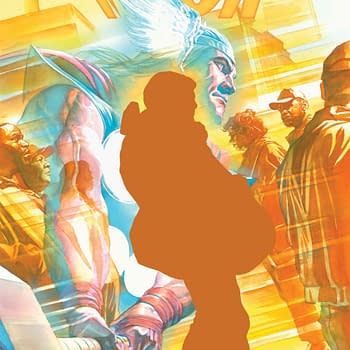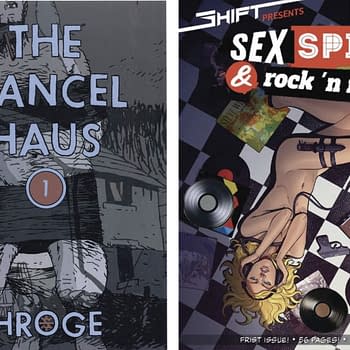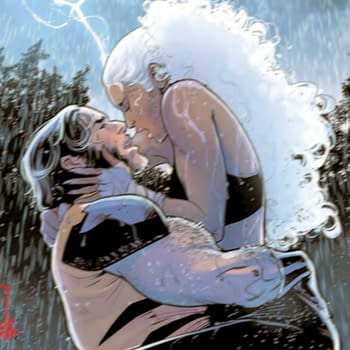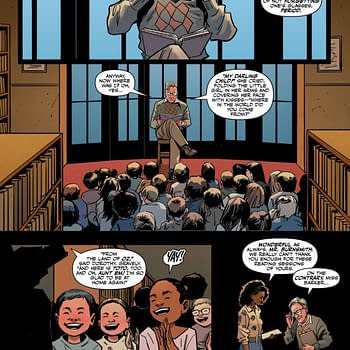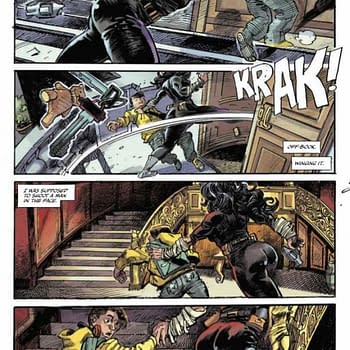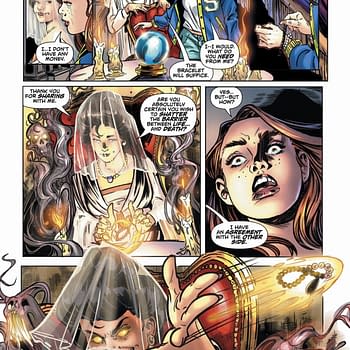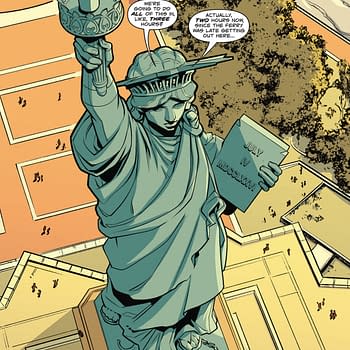Posted in: Comics, Denver Comic Con | Tagged: denny o'neill, denver comic con, neal adams
The Neal Adams/Dennis O'Neil Team Up At Denver Comic Con
On Sunday at the Denver Comic Con, fans piled into the large main event space to hear true comics legends Neal Adams and Dennis O'Neil sit down together to compare their memories of projects they worked on together, including Superman vs. Muhammad Ali and Green Lantern/Green Arrow. The duo only started appearing at events together in the summer of 2012, initially at a charity event in New York, but the team-up went so well that they've continued to appear together, and may well be participating in future talks together, particularly to chat about the socially progressive elements in their work. When these two get sentimental, they tell the kinds of insider anecdotes that fans obsess over, often opening with phrases like, "I walked into Julie Schwartz's office and said…".
The panel kicked off with a discussion of their work on Superman vs. Muhammad Ali, and focused on experiences that both Adams and O'Neil unilaterally considered "strange", perhaps the strangest in their long careers. O'Neil, who's known for his social conscience and bringing salient political and cultural themes into his works, said that he particularly admired Ali "as an athlete and a pacificst", but was also wowed, upon meeting him, by the man's "presence" just walking into a room. O'Neil related that he and Adams went out to Chicago to spend an afternoon with the "Domestic Islam Society" to "meet an infamous guy on his home turf". But when Ali wasn't available, they ended up talking at length with a representative of the society who needed to give his blessing to their upcoming comic. Adams added to O'Neil's "soft core version" of the story by clarifying that they went to be "okayed" by the Islam Society as the writer and artist on the book and keenly felt themselves to be "two Irish guys" and could only describe the meeting as "very, very weird". They visited a compound, O'Neil said, that took up a "whole block" before meeting with the Honorable Elijah Muhammad. In the end, their earnest good intentions for the book won them a stamp of approval and the project went ahead.
O'Neil hit a popular fan question of "What was it like to work with Neal Adams?" head on by explaining that he and Adams often saw each other socially in the small world of New York superhero comics, but as for professional interaction, that was limited by the normal exchange of work at DC Comics via an editor. But O'Neil's view of their collaboration on Green Lantern/Green Arrow has not diminished with time, especially their engagement with drug addiction in the comic. He feels, he said, that the "last 3 panels of the first chapter" of their first GL/GA work is as "as good as anything comics have ever done". The backstory that Adams and O'Neil shared included visiting a drug rehab clinic for the day that changed many of their commonly held assumptions about addiction.
Adams broke into the narrative by going back in time to the origin of the collaboration and how and why it came about. Gil Kane, Adams said, was a "big hero" of his and he heard that Kane was leaving Green Lantern, at which point he asked Julie Schwartz directly if he could take over the art on the book. Schwartz clarified that DC was intending to cancel the book soon, but Adams wanted it anyway to be part of the history of the series before it ended, even if only for a couple of issues. Green Arrow, Schwartz felt, was a character who had developed in surprising ways since his appearance in The Brave and the Bold, and it gave him the idea of a Green Lantern/Green Arrow team-up. But Adams wasn't convinced, saying, "That's the dumbest idea I've ever heard in my life. It's stupid." Tying together two "green" themed characters, particularly, seemed like a bad idea. But if anyone could pull off the team-up, he knew it was Dennis O'Neil, and O'Neil found his way by separating the roles of the two characters pretty radically, presenting Green Lantern as a "protector of a middle/upper class type" and making Green Arrow out to be "upset and angry" on behalf of the "little people". "Fortunately, execs at DC had no idea what we were doing", Adams added, referring to the social elements they were bringing into a discussion of heroic roles.
O'Neil jumped in to the narrative with his own view of the characters he was writing at the time. He described Green Lantern as a "demigod" and Green Arrow as a just a "guy who's really good at shooting arrows", a comparison that made the audience laugh and spelled out the problems O'Neil faced with the script. O'Neil decided to turn Green Arrow into a "streetwise, radical guy", and Adams drew visual inspiration from Erol Flynn's role in Robin Hood, interpreting him as a "smiley character" with a kind of indomitable conviction. Adams commented that he wants "to tell the guy in the show to smile a little", feeling that the current Arrow TV series is a little grimly portrayed. O'Neil, who characterized himself as a "radical tree hugger back them" asked the audience, "Don't you get tired of rich guys being vigilante crime fighters?" He certainly felt that way when writing GL/GA. Adams chimed in that he saw this as a fundamental difference between DC and Marvel heroes, saying "DC had the most boring superheroes on earth, with white teeth, good jobs, etc. who suddenly became superheroes". Whereas, Adams said, at Marvel you had "flawed monsters" who "turn into heroes", something he obviously deemed preferable.
When asked about their work together on Batman, and how much editorial control Julie Schwartz asserted over their work, O'Neil replied that "by that time he really trusted us" and that he and many others were tired of the "comedic show" version of Batman presented by the 1966 TV series. He actually, he said, had "no problem with camp", but felt that " not many common people got camp" and didn't see the higher artistic objectives within it. The Batman comic was hitting a real slump, and Schwartz asked for ideas to revamp the series. O'Neil decision to present a "darker" Batman lay partly in the fact that he didn't feel he'd be any good at writing a camp Batman in keeping with the show. He "remembered those early stories the way we thought they were", meaning the "roots" of the detective comics Batman, but admitted, that looking back through those comics, only "about 4 issues" were really as dark as he remembered them to be. But if anyone could handle the artwork on a Batman returning to his noir roots, it was Adams, O'Neil said, stating "If Batman existed in real life, he had to look like Neal drew him".
Adams had a more colourful and confrontational story to tell when it came to working on Batman. He recalls going into a "darkened room with a projector" at DC to see Schwartz and saying, "So, Batman sucks. Can I do an issue?" and being told, "Get the hell out of my office". This encounter was repeated many times with only minimal variation, still not getting the go ahead from Schwartz. Adams side-stepped the impasse by going to Murray Boltinoff and asking to work on The Brave and the Bold specifically to draw Batman in its pages. When he was asked what he wanted to change about the Batman comics, he said, "I want them to happen at night. And I don't want him to come in doors. That's all really". Changing Batman in the series led to favorable fan response and more clashes with Schwartz. Adams dramatically narrated being confronted at DC during a power outage by Schwartz demanding why fan letters were saying that "the only Batman at DC is in The Brave and the Bold". Adams responded in typically gutsy manner about this revamp of Batman that "Every kid in America knows who Batman is. The only people who don't know are at DC".
Adams and O'Neil spent the latter part of their panel talking about the Comics Code and the impact of Frederic Wertham's Seduction of the Innocent on what comics felt that they could and could not get away with presenting in terms of darker themes and social realism. Wertham had "decent, honorable men running scared", O'Neil said. O'Neil was circumspect about Wertham's other achievements, acknowledging both that Carol Tilley's recent research at the Library of Congress has shown that Wertham "cooked the books" on his data about the affect of comics on children, but also that he was a "good guy in other ways", especially his free clinic work in New York.
What O'Neil was getting around to was the controversy over the cover of GL/GA wherein Speedy is shown taking heroin, a cover that Adams described as the point when the "shit hit the fan". Schwartz "dropped the cover like a hot potato", Adams said, despite the fact that O'Neil and Adams had "pretty much attacked everything but that" in the comic without editorial really noticing. So the cover was rejected as being well beyond the definitions of the Comics Code, but Adams related visiting a friend at Marvel and becoming aware that Stan Lee was attempting to put out a Spider-Man comic handling drug themes with a questionable cover too. He waited to see what the outcome would be, Adams said, and when he heard that Lee had decided to publish the book without the Comics Code seal, and that "no one had noticed", he'd had enough of holding back on GL/GA. According to Adams, DC "went nuts" when they found out that Stan had "beat them to it" and put out the GL/GA cover, which in turn led to a "new code" rapidly in comics.
O'Neil and Adams were informed that their panel time was nearly up, and both expressed disappointment since they were only "getting started", and to all appearances this was definitely true- the two became more animated and enthusiastic as the panel went on, sharing their stories with excitement and plenty of dramatic gusto. They discussed, in closing, the reframing of the Green Lantern hero as an African American, John Stewart, which Adams described as an observation on his part that "white guys" are not the best athletes necessarily, and pointing out to Schwartz that if he watched the Olympics, the top performers were often Asian or African American. He coaxed Schwartz into asking him if he really wanted to change the race of Green Lantern and argued firmly that a change was in order and that he wanted O'Neil to write it. When Adams and O'Neil wrapped up their discussion, really only the jumping on point to much more that the two could have shared about their time in comics, they did so to a standing ovation from fans. Getting Adams and O'Neil into a panel together clearly inspires them to build on each other's memories and conjure up the excitement and determination they felt working on their ground-breaking books. Their mutual stories are enough to fill a few books of their own, and probably should, hopefully. For now, getting them together again is an excellent way to get the inside scoop on the makings of comics history from some real game-changers.
Hannah Means-Shannon is a comics journalist and scholar working on books about Alan Moore and Neil Gaiman for Sequart.org. She is @HannahMenzies on Twitter and @hannahmenziesblog on WordPress.









